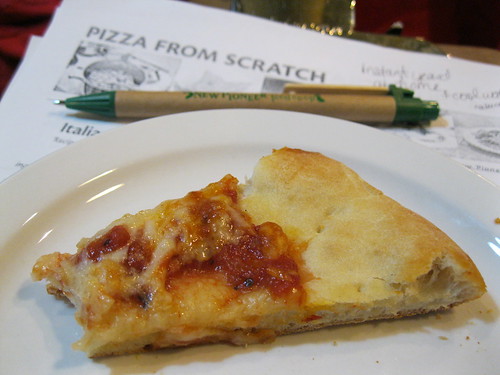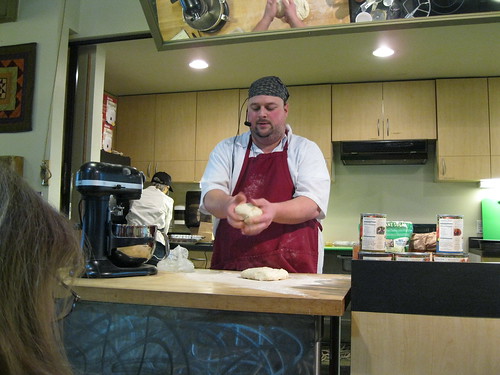 |
| Pizza from Scratch at New Pioneer Food Coop |
I recently spent two delicious hours watching Chad Clark of blinddogpizza.com prepare five pizzas. The class was held at New Pioneer Food Co-op in Coralville. Chad is one of the good folks who turns out a host of fine breads and pastries sold at the Co-op. (It is well that we don’t live so near the Co-op.)
Chad mixed dough for five pizzas and then baked pies using dough prepared the day before. Small pieces were passed around to the class. We sampled thin crust, herbed crust, cornmeal crust and cracker-style crust, all made with cheeses sold at New Pi (including an imported Provolone that many folks ran to purchase as soon as class was over).
 |
| Chad Clark making pizza dough |
Chad’s been making pizza since he was young. Starting with a recipe from his mother, he went on from there, learning the techniques and peculiarities of pizza in its many forms—everything from thin, cracker-like crusts to double-crust stuffed pizza. He very generously offers free recipes for all kinds of pizza crusts on his website and you can occasionally catch him in a class as I did.
A few things I learned:
• If you want springy chewy pizza crust, use bread flour because of its higher gluten content.
• Roll to the edge or not? When rolling out dough, do not roll over the edge of the dough if you want a risen and springy crust. Rolling over the edge releases gases built from yeast production. However, if you are making a thin cracker crust pizza, then you should roll over the edge because this type of crust should not rise or contain air pockets. If you listen carefully as you roll, you can hear little popping sounds as the air pockets burst.
• Bake the crust for a few minutes and then dress it. It can be a challenge to slide a loaded crust onto the pizza stone because sometimes the crust gets caught on the stone, deforming the crust and sloshing the toppings all about. This can be prevented with a slightly baked crust which is firm and easier to manoever onto a baking stone. Chad baked the crusts a couple minutes until they were firm, then removed them to the counter, added sauce and toppings, and returned them to the oven to finish baking.
This was a fun class and it should improve my pizza skills, but even imperfect pizzas can be pretty good.
Right on! Best of luck!
ReplyDelete